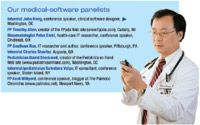Handheld devices: Finding the best programs
Here's expert advice to find the best medical software for your handheld computer.
Medical software for handheld computers is slowly but surely going online and wireless.

Web-based software for handhelds parallels the rise of the ASP, or application service provider, model for electronic health record and practice management systems, in which software is hosted on a remote computer and typically accessed via the Internet.
Physicians benefit from this new distribution model, too. Rather than having to periodically download new versions of software, a doctor with an Internet-enabled handheld automatically taps into the latest and greatest. That's no small matter, since the content of medical software is constantly being updated and expanded to improve patient care and streamline your work.
The rise of Web-based software reflects a sea change in hardware preferences. The traditional personal digital assistant, or PDA, was designed for "native" programs-software installed on the device itself. However, PDA sales are falling as professionals and consumers alike turn to all-purpose smartphones like the iPhone and the BlackBerry, which combine a telephone, Internet connectivity, and PDA computing power.
Still, it would be a mistake to say that medical handheld computing is nothing but Net. While some doctors use their smartphones to access software online, most still rely on native programs, by all accounts-and not just out of habit. You can't always count on Internet connectivity through cellular lines or wireless networks. What's more, software runs a tad slower via the Web. As Internet connectivity becomes more widespread and reliable and online programs speed up, the smartphone's Web browser could become the primary gateway to medical software.
The device is only as good as the software
To help you narrow down your choices in medical software, we've compiled a list of 10 leading programs in six major categories-drug reference, general medicine reference, patient tracking, calculators, coding and charge capture, and e-prescribing. (This roster updates an article titled "10 great programs for your PDA," in the Dec. 2, 2005, issue of Medical Economics at http://www.memag.com/.)
In assembling a roster of programs, we received guidance from a panel of eight primary-care doctors who also contributed to our 2005 story. In addition to their individual use of handhelds, most of our panelists teach or write about their applications in medicine. For every recommended program, we note what handheld operating system (OS) it runs on. For years, OS choices for medical software boiled down to either Palm or Windows Pocket PC. In 2008, OS categories are longer and more complex, with the addition of the BlackBerry OS, the Symbian OS for Nokia phones, and numerous permutations of Windows Mobile, the successor to Windows Pocket PC.
With a browser-equipped handheld, however, you needn't worry about the operating system. You can simply log into the software online. The little device in your hand is opening up a worldwide Web of medicine.
